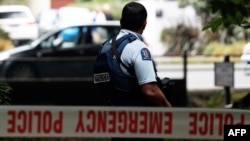Investigators piecing together the motivations of the suspected gunman behind New Zealand's worst terrorist attack are poring over the 87-page hate-filled manifesto he published, and the memes, cultural references in his online rantings, and musical allusions contained in the video he took of the deadly incident.
Then there is the multilingual lettering scrawled on his guns, with references to various figures from history, past and more recent: Serbian, Italian, Hungarian, Ukrainian. And then there's the Georgian king and Georgian consort from the 12th century.
In all, 49, people were killed and more than 20 wounded in the March 15 attack on two mosques in the New Zealand city of Christchurch. An Australian man who claimed responsibility for the shootings said in a manifesto that he came to New Zealand only to plan and prepare for the attack.
For Georgians, the references are perplexing and worrying.
A spokesman for the country's State Security Service told the Georgian news agency Agenda.ge that the service was cooperating with partners regarding the weapons seized from the gunman.
What appears to link the names together, Georgian or otherwise, is the figures were all participants in major battles or military conflicts with Islamic armies from history: variously called Ottoman, Persian, Seljuk, or Turkish, depending on the era and the author.
David The Builder
One of the two Georgian names is a king known to nearly all Georgian schoolchildren: David IV, or David the Builder. Formally known as Davit Aghmashenebeli in Georgian, he was ruler of the Christian kingdom in the 12th century when it was attacked by the armies of the Seljuk Empire, an empire of various Muslim communities that, at its height, stretched from the Aegean Sea to what is today northern Afghanistan.
At the Battle of Didgori, the Georgian army defeated much larger Seljuk forces in 1121, and led the way for Georgia to expand its own kingdom between the Caspian and Black seas. The victory is called "miraculous" in Georgian, and its literature and culture is littered with references to the event.
The second name was David Soslan, who was a military leader and husband of the Georgian queen at the time, Tamar. He played a key role in leading Georgian forces in battles several decades later, against Islamic forces at Shamkor -- in what is today's Azerbaijan -- and Basian- in what is today's Turkey.
David Soslan is not nearly so well known in Georgian culture, possibly because he wasn't considered as royal as his wife, but also because, according to some sources, he was ethnically Ossetian, another ethnic group living in close proximity to Georgia and Russia.
How the two Georgian leaders became associated with the white nationalism of the New Zealand gunman wasn't immediately clear.
However, in his online manifesto and other writings, the gunman, who identified himself as an Australian called Brenton Tarrant, expresses extreme hatred for Muslims.
Breivik 'Inspiration'
One other obscure name scrawled on Tarrant's guns also caught the attention of online observers trying to figure out his motivations: the name of Pavlo Serhiyovych.
Formally known as Pavlo Lapshyn, he hailed from the Ukrainian city of Dnipro, and traveled to England in early 2013 on a temporary work visa, according to a report in the online publication Open Democracy.
Five days after arriving, he stabbed an 82-year-old man named Muhammad Saleem to death as he walked home in Birmingham. Lapshyn later confessed to the crime, telling investigators he killed Saleem because he hated "non-whites."
He also admitted planting bombs at mosques in three towns in central England.
He was sentenced to 40 years in prison in October 2013.
Many more of the names written on Tarrant's guns focus on the history of the Balkans, and conflict, past and present, between Christian and Muslims there.
That includes the legendary Serbian knight Milos Obilic and Serbian Prince Lazar Hrebeljanovic, who both fought against the Ottoman Turks at the Battle of Kosovo in 1389.
The names of several other Balkan figures who fought against the Turks over the centuries are also scrawled on Tarrant's weapons.
In his manifesto, Tarrant wrote that he "only really took true inspiration" from Anders Breivik, the Norwegian far-right terrorist who killed 77 people in a bomb-and-gun attack around Oslo in 2011.
Before his attack, Breivik published a 1,500-page treatise with hundreds of references to the conflicts in the Balkans.








![Pavlo Lapshyn (circled) has been described by some who knew him in his hometown as "quiet and diligent," with his teacher saying, "Our first reaction was that there might have been some mistake, that [Pavlo] couldn't have done it."](https://gdb.rferl.org/1489A508-1A43-46BB-B15B-9EA8526CF4FD_cx11_cy7_cw70_w100_r1.jpg)









